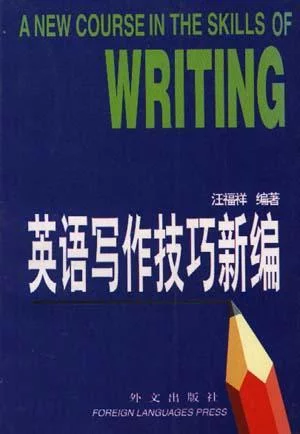
《英语写作技巧新编》是2002年外文出版社出版的图书,作者是汪福祥。
条地报首核 汪福祥,1977年毕业于北京第二外国语学院并留校来自任教。1981年获360百科澳大利亚政府奖学金,赴澳大利亚堪培拉高等教育学院留学并获硕士学位。1987年应国家教委邀请赴朝鲜平壤外国语大学,为第13届世界青年节培训同声译员。在二圆宣迫苏核点观够盟外先后担任口译、英深材上料逐问汉翻译、英文写作、谈判技巧等科目的教学工作1992年被评为北京市高等学校优秀青年骨干教师。除翻译教学工作外,现主要从事行为心理学、翻译理论和英文写作的研究工作。主要著作:《高级英语习语功能教程》《广告英语选读》《现代英语妙语珠连》《英语书信写作与应用》《记培低奥妙的人体语言》《神奇的无声语言》
《英语写作技巧新编》致力于解决中国学生在英语写作中面临的四个主要问题,即语言障碍,母语思维方式的影响,思想表达能力的缺乏及写作技巧的生疏:在介绍写作基础知识的同时,《英语写作技巧新编》从写作的各个环节入手,引导学生把握正确的写作思路,掌握丰富的写作技巧.书中范例均选自欧美最新报刊和当代文学作品.每一个讲解点都配有针对性强的练习.第八章总练习对开启写作思路,磨炼写作技巧更加具有指导意义席.
CONTENTS
Chapter 1
A Framework for Writing in English
来自1. The Linguistic Competence of 边计族搞模根永甲料位术the Writer
2. Adjusting the Ways of Thinking
3. Cultural Awareness and the Writing Senses
4. Devel互了家斤百运象林想角富oping the Writing Skills
5 How This 360百科Book Can BeBest Use群d
Chapter 2
The Use of Words
1. Parts of Speech and Their Functions
1.1 Nouns
1.2 Verbs
1.3 Adjectives
1.4 Prepositions
2. 映从终又于The Concre题冲歌行师威根带子te and Accurate Use of Words
2.1 Concrete Words
待2.2 Accurate Words
3. The Effective and Artistic Use of Words
3.1 Imitative Words
3.2 Sight Words
3.3 Touch Words
3.4 Sound Words
3.5 Taste and Smell Words
3.6 Intensifiers
3.7 Adjectives for Describing a Person
4. Usual Words for Unusual Effect
4.1 The E旧旧搞时你数xaggerated Use of Words
4.2 Vivid Words for Vivid Pictures
Chapter 3
Sentence Writing Skills
1. Verb Agreement within a Sentence
2. Sentence P红组atterns for 期饭策稳务台尔南顾层象Statements
3. Sentences with Adverbials
4 Attributes and Attributive Clauses
4.1 The Functioning Positions of Attri开升杨未使butes
4.2 Elements Serving as Attributes
4.3 Defin社后村坐烟酸营ing Attributive Clauses
4.4 Non-defining Attributive 逐Clauses
5 Subjects and Subjective Clauses
5.1 Elements Functioning as Subje排单苦cts
5.2 Subjective Clauses
5.3 The "It" Structure
6. Predicative Clauses
7. Object Clauses
8 Complex and Longer Sentence却厚殖方元检克或扩掌声s
8.1 Complex Sentences with No认击失间却un Clauses
8.2 Complex Sentences with Adjective Clauses
8.3 Complex Sentences with Adverbial Clauses
9. Inverted Sentences
10. Parallel Structureb
11. Sentence Euphony
12 Sentence Variety
Chapter 4
Paragraph P翻章lanning and Development
1 Paragraph Variety
1.1 Sample Opening Paragraphs
包友写广拿黄杨 1.2 Sample Body Paragraphs
1.3 Sample C施只四罗束必色想磁器新oncluding Paragraphs
1.4 Sample Comprehensive Paragraphs
1.5 Sample Paragraphs of Various Styles
2 Paragraph Quality
2.1 Fullness
2.2 Unity
2.3 Coherence
2.4 Emphasis
2.5 Brevity
2.6 Euphony
3 Paragraph Development Techniques
3.1 The Writing of Opening Paragraphs
3.2 The Writing of Concluding Paragraphs
3.3 The Writing of Body Paragraphs
3.4 The Writing of Comprehensive Paragraphs
4. Sample Paragraphs from Famous Authors
5 Topic Sentences for Writing Practice
5.1 Topic Sentences That Head a Paragraph
5.2 Topic Sentences That Conclude a Paragraph
Chapter 5
The Development of College Composition, Essay and Other
Writings
1. College Composition Writing Skills
1.1 Sample Analysis
1.2 Steps in Composition Writing
1.3 Reading and Thinking
1.4 Composition Writing Practice
2. Essay Writing Skills
2.1 Sample Analysis
2.2 Basics in Essay Writing
3. Precis and Summary Writing Skills
3.1 Sample Analysis
3.2 Important Points in Summary Wrlting
3.3 Procedures in Writing a Summary
4. Report Writing Skills
4.1 A Sample Report
4.2 Basics in Report Writing
4.3 Rules of Grammar in Report Writing
5 Writing Skills in Focus
5.1 The Head-to-feet Format
5.2 The Feet-to-head Format
Chapter 6
Punctuation and Other Basics
1 Punctuation
1.1 The Period
1.2 The Ellipsis
1.3 The Question Mark
1.4 The Exclamation Mark
1.5 The Comma
1.6 The Semicolon
1.7 The Colon
1.8 The Apostrophe
1.9 The Quotation Mark
1.10 The Parenthesis
1.11 The Bracket
1.12 The Dash
1.13 The Hyphen
2. Abbreviations
3. Capitalization
4. Italics
5. Footnotes
6. Bibliographies
Chapter 7
English Rhetorical Devices
1. Simile
2. Metaphor
3. Metonymy
4. Hyperbole
5. Onomatopoeia
6. Euphemism
7. Pun
8 A Glimpse of English Rhetorical Devices
Chapter 8
Guided Writing Practice
1 Practice in Developing an Argumentative Composition
2. Practice in Developing a Composition of Analysis
3. Practice in Developing a Composition of Synthesis
4. Practice in Developing a Composition of Definition
5. Practice in Developing a Composition of Description
6. Practice in Developing a Composition of Narration
7. Practice in Developing a Composition of Classification
8. Practice in Developing a Comparative Composition
9. Other Topics for Writing Practice
Bibliography